Рейтинг книг Sylvie Forestier
Начиная изучать творчество писателя - уделите внимание произведениям, которые находятся на вершине этого рейтинга. Смело нажимайте на стрелочки - вверх и вниз, если считаете, что какое-то произведение должно находиться выше или ниже в списке. В результате общих усилий, в том числе, на основании ваших оценок мы и получим самый адекватный рейтинг книг Sylvie Forestier.
-
1.
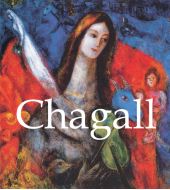 Marc Chagall was born into a strict Jewish family for whom the ban on representations of the human figure had the weight of dogma. A failure in the entrance examination for the Stieglitz School did not stop Chagall from later joining that famous school founded by the Imperial Society for the Encouragement of the Arts and directed by Nicholas Roerich. Chagall moved to Paris in 1910. The city was his “second Vitebsk”. At first, isolated in the little room on the Impasse du Maine at La Ruche, Chagall soon found numerous compatriots also attracted by the prestige of Paris: Lipchitz, Zadkine, Archipenko and Soutine, all of whom were to maintain the “smell” of his native land. From his very arrival Chagall wanted to “discover everything”. And to his dazzled eyes painting did indeed reveal itself. Even the most attentive and partial observer is at times unable to distinguish the “Parisian”, Chagall from the “Vitebskian”. The artist was not full of contradictions, nor was he a split personality, but he always remained different; he looked around and within himself and at the surrounding world, and he used his present thoughts and recollections. He had an utterly poetical mode of thought that enabled him to pursue such a complex course. Chagall was endowed with a sort of stylistic immunity: he enriched himself without destroying anything of his own inner structure. Admiring the works of others he studied them ingenuously, ridding himself of his youthful awkwardness, yet never losing his authenticity for a moment. At times Chagall seemed to look at the world through magic crystal – overloaded with artistic experimentation – of the Ecole de Paris. In such cases he would embark on a subtle and serious play with the various discoveries of the turn of the century and turned his prophetic gaze like that of a biblical youth, to look at himself ironically and thoughtfully in the mirror. Naturally, it totally and uneclectically reflected the painterly discoveries of Cézanne, the delicate inspiration of Modigliani, and the complex surface rhythms recalling the experiments of the early Cubists (See-Portrait at the Easel, 1914). Despite the analyses which nowadays illuminate the painter’s Judaeo-Russian sources, inherited or borrowed but always sublime, and his formal relationships, there is always some share of mystery in Chagall’s art. The mystery perhaps lies in the very nature of his art, in which he uses his experiences and memories. Painting truly is life, and perhaps life is painting. ... Далее
Marc Chagall was born into a strict Jewish family for whom the ban on representations of the human figure had the weight of dogma. A failure in the entrance examination for the Stieglitz School did not stop Chagall from later joining that famous school founded by the Imperial Society for the Encouragement of the Arts and directed by Nicholas Roerich. Chagall moved to Paris in 1910. The city was his “second Vitebsk”. At first, isolated in the little room on the Impasse du Maine at La Ruche, Chagall soon found numerous compatriots also attracted by the prestige of Paris: Lipchitz, Zadkine, Archipenko and Soutine, all of whom were to maintain the “smell” of his native land. From his very arrival Chagall wanted to “discover everything”. And to his dazzled eyes painting did indeed reveal itself. Even the most attentive and partial observer is at times unable to distinguish the “Parisian”, Chagall from the “Vitebskian”. The artist was not full of contradictions, nor was he a split personality, but he always remained different; he looked around and within himself and at the surrounding world, and he used his present thoughts and recollections. He had an utterly poetical mode of thought that enabled him to pursue such a complex course. Chagall was endowed with a sort of stylistic immunity: he enriched himself without destroying anything of his own inner structure. Admiring the works of others he studied them ingenuously, ridding himself of his youthful awkwardness, yet never losing his authenticity for a moment. At times Chagall seemed to look at the world through magic crystal – overloaded with artistic experimentation – of the Ecole de Paris. In such cases he would embark on a subtle and serious play with the various discoveries of the turn of the century and turned his prophetic gaze like that of a biblical youth, to look at himself ironically and thoughtfully in the mirror. Naturally, it totally and uneclectically reflected the painterly discoveries of Cézanne, the delicate inspiration of Modigliani, and the complex surface rhythms recalling the experiments of the early Cubists (See-Portrait at the Easel, 1914). Despite the analyses which nowadays illuminate the painter’s Judaeo-Russian sources, inherited or borrowed but always sublime, and his formal relationships, there is always some share of mystery in Chagall’s art. The mystery perhaps lies in the very nature of his art, in which he uses his experiences and memories. Painting truly is life, and perhaps life is painting. ... Далее -
2.
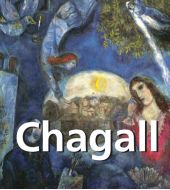 Marc Chagall (Vitebsk, 1887 – Saint-Paul-de-Vence, 1985) Chagall est né dans une famille juive de stricte obédience pour laquelle l’interdit de représentation de la figure humaine avait valeur de dogme. Après un échec à l’examen d’entrée à l’école des Arts et Métiers du baron Stieglitz, Chagall intègre plus tard celle fondée par la Société impériale d’encouragement des Beaux-Arts dirigée par Nicolas Roerich. En 1910, il s’installe à Paris qui sera son «second Vitebsk ». Chagall retrouve à la Ruche de nombreux compatriotes attirés, eux aussi, par le prestige de Paris. Lipchitz, Zadkine, Archipenko, Soutine qui maintiendront, autour du jeune peintre, le parfum de sa terre natale. Les auteurs des premières études sur Chagall relevaient déjà que Paris avait influencé sa manière picturale, avait apporté une nervosité frêle et une netteté aux lignes qui répondent avec assurance et justesse à la couleur et pour beaucoup, la commandent. L’observateur le plus attentif, le plus passionné, se révèle parfois incapable de distinguer le Chagall «de Paris » du Chagall «de Vitebsk ». L’artiste n’est pas contradictoire ni «dédoublé », mais il demeurait constamment ouverts, regardant en lui et autour de lui, considérant le monde environnant, les idées de son époque, les souvenirs du passé. Chagall est doué d’une sorte «d’immunité stylistique », il s’enrichit sans rien détruire de sa propre structure. Il s’enthousiasme, apprend en toute ingénuité, se défait de la maladresse juvénile, mais sans perdre son «authenticité ». Parfois, c’est comme s’il regardait le monde à travers le prisme magique de l’école de Paris. Alors il engage un jeu tout en finesse et en sérieux avec les découvertes du tournant du siècle, alors l’adolescent se considère, ironique et songeur, dans un miroir où s’unissent tout naturellement les acquis picturaux de Cézanne, la spiritualisation fragile de Modigliani, les rythmes complexes des plans qui rappellent les expériences des premiers cubistes (Autoportrait devant le chevalet, 1914). Cependant, au-delà des analyses qui, aujourd’hui, éclairent les sources judéo-russes du peintre, les filiations formelles héritées ou empruntées, mais toujours sublimées, une part de mystère demeure dans l’art de Chagall. Ce mystère tient peut-être à la nature même de cet art qui puise dans le souvenir. ... Далее
Marc Chagall (Vitebsk, 1887 – Saint-Paul-de-Vence, 1985) Chagall est né dans une famille juive de stricte obédience pour laquelle l’interdit de représentation de la figure humaine avait valeur de dogme. Après un échec à l’examen d’entrée à l’école des Arts et Métiers du baron Stieglitz, Chagall intègre plus tard celle fondée par la Société impériale d’encouragement des Beaux-Arts dirigée par Nicolas Roerich. En 1910, il s’installe à Paris qui sera son «second Vitebsk ». Chagall retrouve à la Ruche de nombreux compatriotes attirés, eux aussi, par le prestige de Paris. Lipchitz, Zadkine, Archipenko, Soutine qui maintiendront, autour du jeune peintre, le parfum de sa terre natale. Les auteurs des premières études sur Chagall relevaient déjà que Paris avait influencé sa manière picturale, avait apporté une nervosité frêle et une netteté aux lignes qui répondent avec assurance et justesse à la couleur et pour beaucoup, la commandent. L’observateur le plus attentif, le plus passionné, se révèle parfois incapable de distinguer le Chagall «de Paris » du Chagall «de Vitebsk ». L’artiste n’est pas contradictoire ni «dédoublé », mais il demeurait constamment ouverts, regardant en lui et autour de lui, considérant le monde environnant, les idées de son époque, les souvenirs du passé. Chagall est doué d’une sorte «d’immunité stylistique », il s’enrichit sans rien détruire de sa propre structure. Il s’enthousiasme, apprend en toute ingénuité, se défait de la maladresse juvénile, mais sans perdre son «authenticité ». Parfois, c’est comme s’il regardait le monde à travers le prisme magique de l’école de Paris. Alors il engage un jeu tout en finesse et en sérieux avec les découvertes du tournant du siècle, alors l’adolescent se considère, ironique et songeur, dans un miroir où s’unissent tout naturellement les acquis picturaux de Cézanne, la spiritualisation fragile de Modigliani, les rythmes complexes des plans qui rappellent les expériences des premiers cubistes (Autoportrait devant le chevalet, 1914). Cependant, au-delà des analyses qui, aujourd’hui, éclairent les sources judéo-russes du peintre, les filiations formelles héritées ou empruntées, mais toujours sublimées, une part de mystère demeure dans l’art de Chagall. Ce mystère tient peut-être à la nature même de cet art qui puise dans le souvenir. ... Далее -
3.
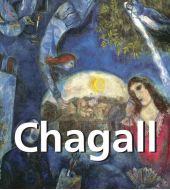 Chagall wurde in einer strenggläubigen jüdischen Familie geboren, in der das Verbot, den Menschen bildlich darzustellen, zum religiösen Dogma gehörte. Zwar lebte Chagalls Familie in ärmlichen Verhältnissen, litt jedoch keine Not. Nachdem er zunächst bei der Aufnahmeprüfung für die Kunstschule des Barons Stieglitz durchgefallen war, gelang es ihm, in die von Nikolai Roerich geleitete Schule der Kaiserlichen Gesellschaft zur Förderung der Künste aufgenommen zu werden. Chagall wählte später als Wohnsitz Paris. In dem Künstlerviertel La Ruche traf er viele Landsleute – u.a. Lipschitz, Zadkine, Soutine und Archipenko –, die, angezogen vom Ruhm der Weltstadt, ebenfalls nach Paris gekommen waren. Bereits in den ersten Schriften über Chagall, die in den 1920er Jahren erschienen, wurde mit Recht behauptet, dass Paris seiner Malkunst den nötigen Schliff gegeben habe, eine sensible Sprödigkeit und Bestimmtheit der Linien, die nun eine sichere und genaue Stimmigkeit mit dem Farbklang bekamen, so dass die Linie gegenüber der Farbe oft zum beherrschenden Element wurde. Chagall besaß von Natur aus eine “stilistische Immunität”, er ließ sich in seinem Schaffen anregen und bereichern, jedoch ohne seinem eigenen Stil untreu zu werden. Er begeisterte sich für das Werk anderer Künstler, lernte von ihnen und streifte seine jugendliche Unbeholfenheit ab, seinen “Archimedespunkt” aber verlor er nie. Bezeichnend ist, dass Kritiker und Forscher in ihren Abhandlungen über Chagalls Kunst häufig zur musikalischen Terminologie greifen. Chagalls Motive und Gestalten verfügen über eine klangliche Wirkung. So erscheint die Farbe als Rhythmus, die Linie als Melodie. Diese Metaphorik entspricht einer Malkunst, die gleich der Musik auf den Begriff der Zeit bezogen ist. ... Далее
Chagall wurde in einer strenggläubigen jüdischen Familie geboren, in der das Verbot, den Menschen bildlich darzustellen, zum religiösen Dogma gehörte. Zwar lebte Chagalls Familie in ärmlichen Verhältnissen, litt jedoch keine Not. Nachdem er zunächst bei der Aufnahmeprüfung für die Kunstschule des Barons Stieglitz durchgefallen war, gelang es ihm, in die von Nikolai Roerich geleitete Schule der Kaiserlichen Gesellschaft zur Förderung der Künste aufgenommen zu werden. Chagall wählte später als Wohnsitz Paris. In dem Künstlerviertel La Ruche traf er viele Landsleute – u.a. Lipschitz, Zadkine, Soutine und Archipenko –, die, angezogen vom Ruhm der Weltstadt, ebenfalls nach Paris gekommen waren. Bereits in den ersten Schriften über Chagall, die in den 1920er Jahren erschienen, wurde mit Recht behauptet, dass Paris seiner Malkunst den nötigen Schliff gegeben habe, eine sensible Sprödigkeit und Bestimmtheit der Linien, die nun eine sichere und genaue Stimmigkeit mit dem Farbklang bekamen, so dass die Linie gegenüber der Farbe oft zum beherrschenden Element wurde. Chagall besaß von Natur aus eine “stilistische Immunität”, er ließ sich in seinem Schaffen anregen und bereichern, jedoch ohne seinem eigenen Stil untreu zu werden. Er begeisterte sich für das Werk anderer Künstler, lernte von ihnen und streifte seine jugendliche Unbeholfenheit ab, seinen “Archimedespunkt” aber verlor er nie. Bezeichnend ist, dass Kritiker und Forscher in ihren Abhandlungen über Chagalls Kunst häufig zur musikalischen Terminologie greifen. Chagalls Motive und Gestalten verfügen über eine klangliche Wirkung. So erscheint die Farbe als Rhythmus, die Linie als Melodie. Diese Metaphorik entspricht einer Malkunst, die gleich der Musik auf den Begriff der Zeit bezogen ist. ... Далее -
4.
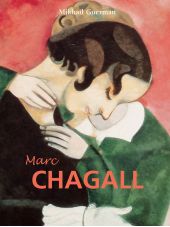 Marc Chagall nació en el seno de una familia judía sumamente estricta, para la cual la prohibición de la representación de la figura humana tenía la fuerza de un dogma. El no haber pasado el examen de admisión de la escuela Stieglitz no evitó que Chagall se uniera posteriormente a esa famosa escuela fundada por la sociedad imperial para el fomento de las artes, dirigida por Nicholas Roerich. En 1910, Chagall se mudó a París. La ciudad fue su “segunda Vitebsk”. Al principio, aislado en su pequeña habitación de Impasse du Maine en La Ruche, Chagall encontró numerosos compatriotas a los que también había atraído el prestigio de París: Lipchitz, Zadkine, Archipenko y Sutin, todos ellos destinados a mantener el “aroma” de su tierra natal. Desde su llegada, Chagall quería “descubrirlo todo”. Ante sus sorprendidos ojos, la pintura se le reveló. Aun el observador más atento y parcial tiene dificultad, en ocasiones, para distinguir al Chagal parisino del de Vitebsk. El artista no estaba lleno de contradicciones, ni tenía una personalidad dividida, pero siempre era distinto; miraba a su alrededor y en su interior, así como al mundo que le rodeaba y usaba sus ideas del momento y sus recuerdos. Tenía un estilo de pensamiento sumamente poético que le permitía seguir un camino tan complejo. Chagall estaba dotado de una cierta inmunidad estilística: se enriquecía a sí mismo sin destruir nada de su propia estructura interna. Admiró la obra de otros y la estudió con inventiva, librándose de su juvenil torpeza, pero sin perder un solo instante su autenticidad. Por momentos, Chagall parecía mirar al mundo a través del cristal mágico, sobrecargado de experimentación artística, de la Ecole de París. En tales casos, se embarcaba en un sutil y serio juego con los diversos descubrimientos del fin de siglo y volvía su mirada profética, como la de un joven bíblico, para mirarse a sí mismo con ironía y de manera pensativa en el espejo. Naturalmente, reflejó por completo y de manera extrema los descubrimientos pictóricos de Cézanne, la delicada inspiración de Modigliani y los ritmos superficiales complejos que recordaban la experimentación de los primeros cubistas (Véase Retrato en el caballete, 1914). A pesar de los análisis recientes que mencionan las fuentes judeo-rusas del pintor, heredadas o prestadas pero siempre sublimes, así como de sus relaciones formales, siempre hay algo de misterio en el arte de Chagall. Un misterio que tal vez descansa en la naturaleza misma de su arte, en el que utiliza sus experiencias y recuerdos. Pintar es la vida, y tal vez, la vida es pintar. ... Далее
Marc Chagall nació en el seno de una familia judía sumamente estricta, para la cual la prohibición de la representación de la figura humana tenía la fuerza de un dogma. El no haber pasado el examen de admisión de la escuela Stieglitz no evitó que Chagall se uniera posteriormente a esa famosa escuela fundada por la sociedad imperial para el fomento de las artes, dirigida por Nicholas Roerich. En 1910, Chagall se mudó a París. La ciudad fue su “segunda Vitebsk”. Al principio, aislado en su pequeña habitación de Impasse du Maine en La Ruche, Chagall encontró numerosos compatriotas a los que también había atraído el prestigio de París: Lipchitz, Zadkine, Archipenko y Sutin, todos ellos destinados a mantener el “aroma” de su tierra natal. Desde su llegada, Chagall quería “descubrirlo todo”. Ante sus sorprendidos ojos, la pintura se le reveló. Aun el observador más atento y parcial tiene dificultad, en ocasiones, para distinguir al Chagal parisino del de Vitebsk. El artista no estaba lleno de contradicciones, ni tenía una personalidad dividida, pero siempre era distinto; miraba a su alrededor y en su interior, así como al mundo que le rodeaba y usaba sus ideas del momento y sus recuerdos. Tenía un estilo de pensamiento sumamente poético que le permitía seguir un camino tan complejo. Chagall estaba dotado de una cierta inmunidad estilística: se enriquecía a sí mismo sin destruir nada de su propia estructura interna. Admiró la obra de otros y la estudió con inventiva, librándose de su juvenil torpeza, pero sin perder un solo instante su autenticidad. Por momentos, Chagall parecía mirar al mundo a través del cristal mágico, sobrecargado de experimentación artística, de la Ecole de París. En tales casos, se embarcaba en un sutil y serio juego con los diversos descubrimientos del fin de siglo y volvía su mirada profética, como la de un joven bíblico, para mirarse a sí mismo con ironía y de manera pensativa en el espejo. Naturalmente, reflejó por completo y de manera extrema los descubrimientos pictóricos de Cézanne, la delicada inspiración de Modigliani y los ritmos superficiales complejos que recordaban la experimentación de los primeros cubistas (Véase Retrato en el caballete, 1914). A pesar de los análisis recientes que mencionan las fuentes judeo-rusas del pintor, heredadas o prestadas pero siempre sublimes, así como de sus relaciones formales, siempre hay algo de misterio en el arte de Chagall. Un misterio que tal vez descansa en la naturaleza misma de su arte, en el que utiliza sus experiencias y recuerdos. Pintar es la vida, y tal vez, la vida es pintar. ... Далее -
5.
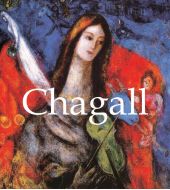 Marc Chagall nació en el seno de una familia judía sumamente estricta, para la cual la prohibición de la representación de la figura humana tenía la fuerza de un dogma. El no haber pasado el examen de admisión de la escuela Stieglitz no evitó que Chagall se uniera posteriormente a esa famosa escuela fundada por la sociedad imperial para el fomento de las artes, dirigida por Nicholas Roerich. En 1910, Chagall se mudó a París. La ciudad fue su “segunda Vitebsk”. Al principio, aislado en su pequeña habitación de Impasse du Maine en La Ruche, Chagall encontró numerosos compatriotas a los que también había atraído el prestigio de París: Lipchitz, Zadkine, Archipenko y Sutin, todos ellos destinados a mantener el “aroma” de su tierra natal. Desde su llegada, Chagall quería “descubrirlo todo”. Ante sus sorprendidos ojos, la pintura se le reveló. Aun el observador más atento y parcial tiene dificultad, en ocasiones, para distinguir al Chagal parisino del de Vitebsk. El artista no estaba lleno de contradicciones, ni tenía una personalidad dividida, pero siempre era distinto; miraba a su alrededor y en su interior, así como al mundo que le rodeaba y usaba sus ideas del momento y sus recuerdos. Tenía un estilo de pensamiento sumamente poético que le permitía seguir un camino tan complejo. Chagall estaba dotado de una cierta inmunidad estilística: se enriquecía a sí mismo sin destruir nada de su propia estructura interna. Admiró la obra de otros y la estudió con inventiva, librándose de su juvenil torpeza, pero sin perder un solo instante su autenticidad. Por momentos, Chagall parecía mirar al mundo a través del cristal mágico, sobrecargado de experimentación artística, de la Ecole de París. En tales casos, se embarcaba en un sutil y serio juego con los diversos descubrimientos del fin de siglo y volvía su mirada profética, como la de un joven bíblico, para mirarse a sí mismo con ironía y de manera pensativa en el espejo. Naturalmente, reflejó por completo y de manera extrema los descubrimientos pictóricos de Cézanne, la delicada inspiración de Modigliani y los ritmos superficiales complejos que recordaban la experimentación de los primeros cubistas (Véase Retrato en el caballete, 1914). A pesar de los análisis recientes que mencionan las fuentes judeo-rusas del pintor, heredadas o prestadas pero siempre sublimes, así como de sus relaciones formales, siempre hay algo de misterio en el arte de Chagall. Un misterio que tal vez descansa en la naturaleza misma de su arte, en el que utiliza sus experiencias y recuerdos. Pintar es la vida, y tal vez, la vida es pintar. ... Далее
Marc Chagall nació en el seno de una familia judía sumamente estricta, para la cual la prohibición de la representación de la figura humana tenía la fuerza de un dogma. El no haber pasado el examen de admisión de la escuela Stieglitz no evitó que Chagall se uniera posteriormente a esa famosa escuela fundada por la sociedad imperial para el fomento de las artes, dirigida por Nicholas Roerich. En 1910, Chagall se mudó a París. La ciudad fue su “segunda Vitebsk”. Al principio, aislado en su pequeña habitación de Impasse du Maine en La Ruche, Chagall encontró numerosos compatriotas a los que también había atraído el prestigio de París: Lipchitz, Zadkine, Archipenko y Sutin, todos ellos destinados a mantener el “aroma” de su tierra natal. Desde su llegada, Chagall quería “descubrirlo todo”. Ante sus sorprendidos ojos, la pintura se le reveló. Aun el observador más atento y parcial tiene dificultad, en ocasiones, para distinguir al Chagal parisino del de Vitebsk. El artista no estaba lleno de contradicciones, ni tenía una personalidad dividida, pero siempre era distinto; miraba a su alrededor y en su interior, así como al mundo que le rodeaba y usaba sus ideas del momento y sus recuerdos. Tenía un estilo de pensamiento sumamente poético que le permitía seguir un camino tan complejo. Chagall estaba dotado de una cierta inmunidad estilística: se enriquecía a sí mismo sin destruir nada de su propia estructura interna. Admiró la obra de otros y la estudió con inventiva, librándose de su juvenil torpeza, pero sin perder un solo instante su autenticidad. Por momentos, Chagall parecía mirar al mundo a través del cristal mágico, sobrecargado de experimentación artística, de la Ecole de París. En tales casos, se embarcaba en un sutil y serio juego con los diversos descubrimientos del fin de siglo y volvía su mirada profética, como la de un joven bíblico, para mirarse a sí mismo con ironía y de manera pensativa en el espejo. Naturalmente, reflejó por completo y de manera extrema los descubrimientos pictóricos de Cézanne, la delicada inspiración de Modigliani y los ritmos superficiales complejos que recordaban la experimentación de los primeros cubistas (Véase Retrato en el caballete, 1914). A pesar de los análisis recientes que mencionan las fuentes judeo-rusas del pintor, heredadas o prestadas pero siempre sublimes, así como de sus relaciones formales, siempre hay algo de misterio en el arte de Chagall. Un misterio que tal vez descansa en la naturaleza misma de su arte, en el que utiliza sus experiencias y recuerdos. Pintar es la vida, y tal vez, la vida es pintar. ... Далее -
6.
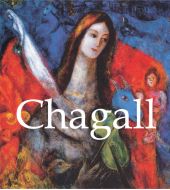 Marc Chagall was born into a strict Jewish family for whom the ban on representations of the human figure had the weight of dogma. A failure in the entrance examination for the Stieglitz School did not stop Chagall from later joining that famous school founded by the Imperial Society for the Encouragement of the Arts and directed by Nicholas Roerich. Chagall moved to Paris in 1910. The city was his “second Vitebsk”. At first, isolated in the little room on the Impasse du Maine at La Ruche, Chagall soon found numerous compatriots also attracted by the prestige of Paris: Lipchitz, Zadkine, Archipenko and Soutine, all of whom were to maintain the “smell” of his native land. From his very arrival Chagall wanted to “discover everything”. And to his dazzled eyes painting did indeed reveal itself. Even the most attentive and partial observer is at times unable to distinguish the “Parisian”, Chagall from the “Vitebskian”. The artist was not full of contradictions, nor was he a split personality, but he always remained different; he looked around and within himself and at the surrounding world, and he used his present thoughts and recollections. He had an utterly poetical mode of thought that enabled him to pursue such a complex course. Chagall was endowed with a sort of stylistic immunity: he enriched himself without destroying anything of his own inner structure. Admiring the works of others he studied them ingenuously, ridding himself of his youthful awkwardness, yet never losing his authenticity for a moment. At times Chagall seemed to look at the world through magic crystal – overloaded with artistic experimentation – of the Ecole de Paris. In such cases he would embark on a subtle and serious play with the various discoveries of the turn of the century and turned his prophetic gaze like that of a biblical youth, to look at himself ironically and thoughtfully in the mirror. Naturally, it totally and uneclectically reflected the painterly discoveries of Cézanne, the delicate inspiration of Modigliani, and the complex surface rhythms recalling the experiments of the early Cubists (See-Portrait at the Easel, 1914). Despite the analyses which nowadays illuminate the painter’s Judaeo-Russian sources, inherited or borrowed but always sublime, and his formal relationships, there is always some share of mystery in Chagall’s art. The mystery perhaps lies in the very nature of his art, in which he uses his experiences and memories. Painting truly is life, and perhaps life is painting. ... Далее
Marc Chagall was born into a strict Jewish family for whom the ban on representations of the human figure had the weight of dogma. A failure in the entrance examination for the Stieglitz School did not stop Chagall from later joining that famous school founded by the Imperial Society for the Encouragement of the Arts and directed by Nicholas Roerich. Chagall moved to Paris in 1910. The city was his “second Vitebsk”. At first, isolated in the little room on the Impasse du Maine at La Ruche, Chagall soon found numerous compatriots also attracted by the prestige of Paris: Lipchitz, Zadkine, Archipenko and Soutine, all of whom were to maintain the “smell” of his native land. From his very arrival Chagall wanted to “discover everything”. And to his dazzled eyes painting did indeed reveal itself. Even the most attentive and partial observer is at times unable to distinguish the “Parisian”, Chagall from the “Vitebskian”. The artist was not full of contradictions, nor was he a split personality, but he always remained different; he looked around and within himself and at the surrounding world, and he used his present thoughts and recollections. He had an utterly poetical mode of thought that enabled him to pursue such a complex course. Chagall was endowed with a sort of stylistic immunity: he enriched himself without destroying anything of his own inner structure. Admiring the works of others he studied them ingenuously, ridding himself of his youthful awkwardness, yet never losing his authenticity for a moment. At times Chagall seemed to look at the world through magic crystal – overloaded with artistic experimentation – of the Ecole de Paris. In such cases he would embark on a subtle and serious play with the various discoveries of the turn of the century and turned his prophetic gaze like that of a biblical youth, to look at himself ironically and thoughtfully in the mirror. Naturally, it totally and uneclectically reflected the painterly discoveries of Cézanne, the delicate inspiration of Modigliani, and the complex surface rhythms recalling the experiments of the early Cubists (See-Portrait at the Easel, 1914). Despite the analyses which nowadays illuminate the painter’s Judaeo-Russian sources, inherited or borrowed but always sublime, and his formal relationships, there is always some share of mystery in Chagall’s art. The mystery perhaps lies in the very nature of his art, in which he uses his experiences and memories. Painting truly is life, and perhaps life is painting. ... Далее
Комментарии:


